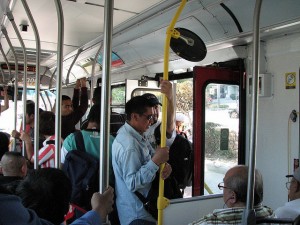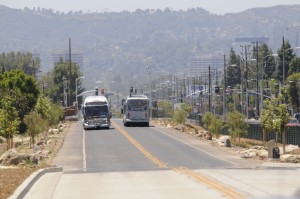So says a new study by researchers Jesper Ingvardson and Otto Nielsen from the Technical University of Denmark, as reported by The City Fix:
Ingvardson and Nielsen compare 86 metro, light rail transit (LRT) and bus rapid transit (BRT) corridors using several variables: travel time savings, increase in demand from riders, modal shift, and land use and urban development changes. In some cases, the much more economical BRTs matched and even outperformed rail.
The key for buses to match or exceed all of these major benefits of rail is to have “buses done right.” That means bus rapid transit in its own dedicated lanes, with fast boarding and frequent service.
The benefits for transit advocates and the public are huge: bus rapid transit is far cheaper than rail (often 1/5 the price) and can get built much more quickly (sometimes in 1/5 the years).
To be sure, rail is appropriate in densely populated environments and travel corridors. But most cities in the United States have many more moderate-density corridors than high-density ones. In these areas, the case for true bus rapid transit is looking more and more like a no-brainer.
 Transit ridership is falling across the country, while driving miles are up. Much of the change is probably due to a relatively strong economy and low gas prices, plus the impact of venture capital-subsidized rideshare companies like Uber and Lyft.
Transit ridership is falling across the country, while driving miles are up. Much of the change is probably due to a relatively strong economy and low gas prices, plus the impact of venture capital-subsidized rideshare companies like Uber and Lyft.
But what about poor transit service, particularly on buses? The ridership decline provides opportunities for transit agencies to rethink their bus systems. But it may not be enough.
Governing.com profiles Columbus, Ohio’s recent efforts on this front:
The Columbus transit agency spent four years and $9.4 million studying its bus network, gathering public feedback and designing alternative routes. All of that work came to a head this May, when COTA switched to a completely new system. It doubled the number of bus lines with frequent service (every 15 minutes or less), deploying many of them along major roads far from downtown. The new routes added or increased service to the airport, shopping malls, a casino and many other job centers. By COTA’s estimate, the number of jobs within a quarter mile (a five-minute walk) of a frequent bus line jumped from 155,000 to 265,000. The number of people who lived within a quarter mile of those lines increased from 116,000 to 219,000. Plus, the agency beefed up service on Saturdays and Sundays. And Columbus did all of it without an increase in funding.
It remains to be seen how effective this redesign will be.
Meanwhile, pre-Hurricane Harvey Houston also redesigned its bus network in the past few years, adding $12 million to the operating budget. But the results were mixed-to-disappointing: ridership increased 6.8 percent in the first year, with most though from increased light rail trips and 1.2 percent from bus trips (weekday trips decreased). Ridership during the second year was flat.
So if a redesign is not enough, what needs to be done? Three things:
- Build more bus-only lanes and bus rapid transit lines. If buses can avoid traffic and beat car travel times, ridership will surge.
- Build more housing and jobs around high-traffic bus corridors (and stop building automobile infrastructure in these areas). The more people living and working near bus lines will boost ridership. And the more cars are not accommodated, such as through locally mandated parking spaces or garages, the faster bus service will be.
- Lower fares. History has shown that lowering fares is a good way to attract more riders. The fare decreases could be paid for by congestion pricing on automobile traffic in key corridors during peak commute times. It’s a double-win: less automobile traffic, more bus ridership.
All of these solutions will require policy action and investment, which means political will to get it done. It’s harder than a bus redesign but will ultimately provide a lasting solution to the ridership challenges.
Count me in as a general well-wisher for bus rapid transit, or BRT. If done right, in dedicated lanes with multiple boarding openings and signal priority, it can mimic much of the benefits of rail (speed and reliability) at a fraction of the cost and time to build.
Many environmentalists and transit advocates agree, which is why more and more BRT lines are being introduced around the country, from Cleveland to San Francisco. Los Angeles has one of the first in the country in the San Fernando Valley (see the photo below — I document the history of the line in my book Railtown, as the one exception to my otherwise-exclusive focus on rail transit history).
But now Benjamin Ross, a transit advocate in Maryland, offers a surprising account of the history of bus rapid transit, with evidence that it originally sprang as an idea by the oil and gas industry and highway lobby to blunt momentum for rail transit.
While he acknowledges that buses are important and that BRT, when done right, can be successful, he ultimately believes that the push for BRT has in too many cases undercut momentum for much more effective rail transit systems. He also decries the “watered down” versions of BRT that lose many of the critical distinctions that make it a speedy and effective mode of moving people.
The account is hardly a paranoid polemic and seems well-balanced. For my part, I think context is everything. There is a reason that BRT has taken hold well beyond the anti-rail, pro-highway forces. Its low price tag, speed of construction, and quality of service are hard to beat and offer the perfect technology for certain corridors and mid-size neighborhoods. For places like Los Angeles, it would be easy to add bus-only lanes to existing highways, and that shouldn’t detract from the push for rail in high-density parts of the region.
But it’s worth considering Ross’s point that BRT advocacy can sometimes go too far and undercut the case for more right-sized transit like rail. His point about decision makers watering down BRT too much is also well taken — it’s not truly BRT without a dedicated lane and signal priority, at the very least.
Meanwhile, transit advocates should keep this mixed history in mind, in order to guard against efforts to divide them or to lower the quality of transit in the ongoing mobility battles in cities across the country and beyond.



